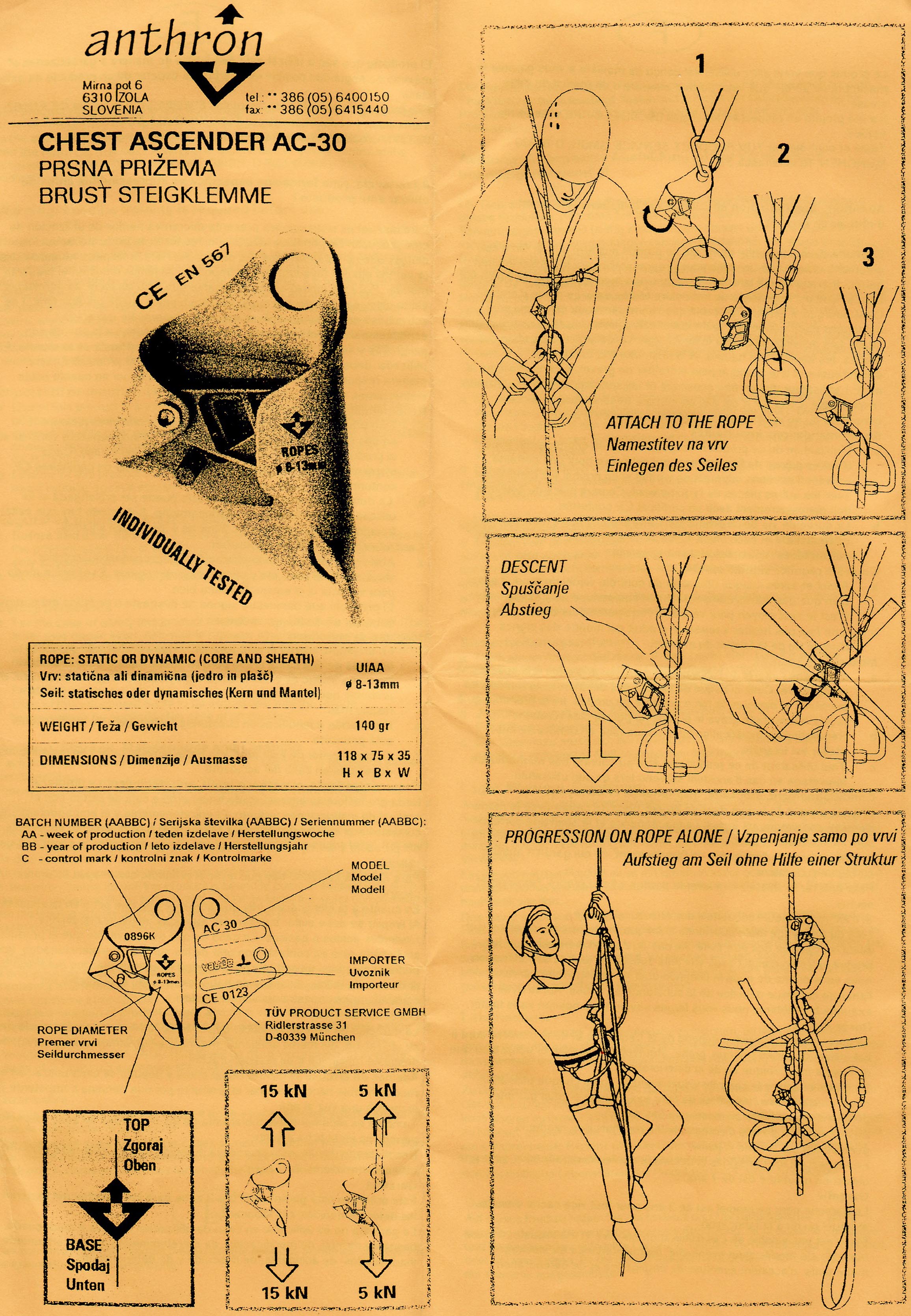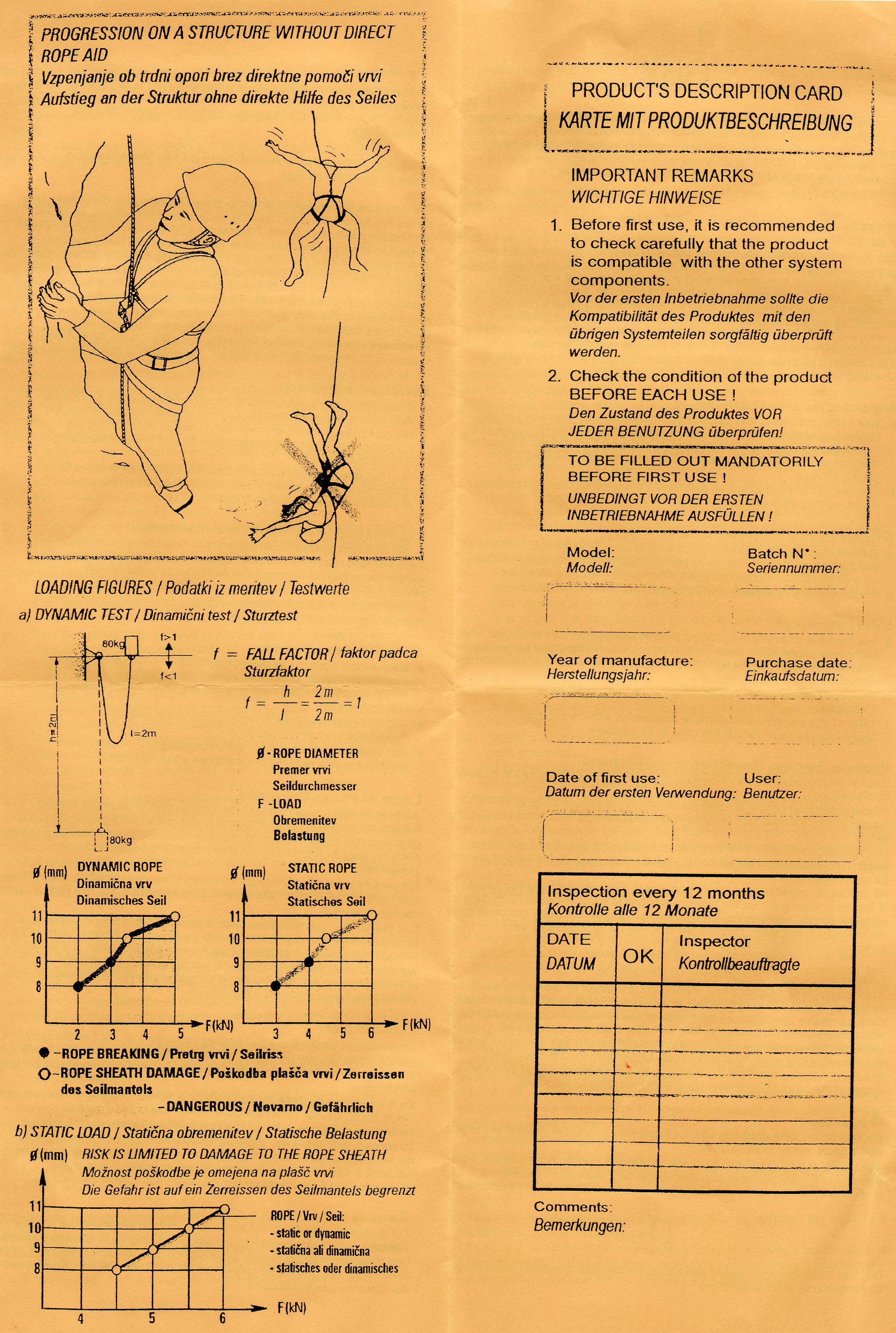Overview
[ Top
| Version B
| Version C
| Return to E.C. Ascenders
]
Version A
(#2150)
Technical Details
I acquired my Anthron AC-30 in 2017 as part of Bob Thrun’s collection.
Like most handleless eccentric cam chest ascenders, the Anthron ascender
is left-handed. This ascender is 119 mm. tall, 80 mm.
wide, 33 mm. thick, and weighs 140 g. The ascender shell is a subtriangular blue anodized shape bent
from 3.9 mm. aluminum sheet. The rope channel is formed by
bending the right side of the ascender into a U. The rope
channel is 15 mm. wide. The main sling attachment
point is located below the cam and behind the rope channel. A
second attachment point is located above the cam, also behind
the rope channel. The shell is bent backwards at both points to
provide clearance between the attachment slings and the main rope.
This accounts for the rather large thickness of this ascender.
The lower attachment point is an oval-shaped opening that measures 18.2
mm. high by 15.3 mm. wide. The upper is a distorted 15.3 mm. round hole. The left side of the shell is bent on an
inclined axis to form another U. A hole drilled through both
sides of the U accepts a semi-tubular rivet. The cam and cam spring
are mounted on this rivet. The head of the rivet is in the rear. The pivot is centered 48 mm. from the inside of the
rope groove. There is a stamped cam stop near the cam pivot.
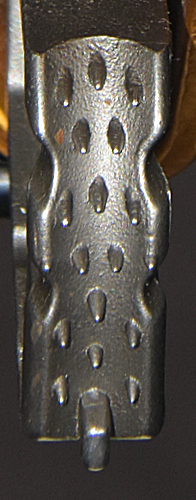 The cam is a skeletonized steel casting. The cam radius, measured from the pivot, increases from 37 to 52 mm. over an angle of 39°, giving a 27° cam angle. The cam has number of small conical teeth, all of which have their axes approximately parallel to the lower surface of the cam. The tooth pattern is (3.2)^2(1.2)^2(B). The B stands for a 4.4 mm. high, 2.3 mm. wide, and 3/6 mm. long bar. There are two notches on each side of the cam face, presumable
for mud relief. Unlike some other ascenders, the inner cam face
radius appears to be constant.
The cam is a skeletonized steel casting. The cam radius, measured from the pivot, increases from 37 to 52 mm. over an angle of 39°, giving a 27° cam angle. The cam has number of small conical teeth, all of which have their axes approximately parallel to the lower surface of the cam. The tooth pattern is (3.2)^2(1.2)^2(B). The B stands for a 4.4 mm. high, 2.3 mm. wide, and 3/6 mm. long bar. There are two notches on each side of the cam face, presumable
for mud relief. Unlike some other ascenders, the inner cam face
radius appears to be constant.
A spring-loaded manual safety (anodized aluminum alloy) is mounted on an axle riveted to the center of the cam. The normal action of the spring holds the safety against the cam. The safety has a 11 mm. long, 5.9 mm. diameter pin to provide a better grip. When the cam is opened, the shell interferes with the safety tab, thus preventing opening the cam. If the safety is moved away from the cam (opposing the spring), the tab will clear the shell and the cam will open. At full open the safety can be released and the spring will hold the a long arm against the back of the shell, locking the cam open.
The front of the ascender is stamped with the Anthron logo, "ROPES," "ø8-13 mm," and, above the cam, "AC-30." The rear is stamped with "4898-H," "ANTHRON," the Anthron logo, and
"CE0123."
My Anthron is a well-built ascender. All sharp edges have been
removed. The attachment points are simply holes in the shell, and
although rounded they should have been beveled more; even so,
I would consider their small radius too sharp for directly attaching
sling ropes. They are probably acceptably rounded for webbing. Considering the proximity of the attachment
points to the main rope, I would recommend using a small maillon
for most attachments in order to reduce the risk of sling abrasion; obviously, this is not an issue for Froggers.
The cam is very well made. The notches
don't seem to provide much help in muddy conditions - but nobody
else’s similar ascender works well either. I'm not sure what purpose
the bar serves - several people have sent me emails telling me
that the bar keeps the cam from closing and touching the shell.
I agree, it does, but so what? Putting the ascender on rope does
the same thing. Initially I wondered if the bar would interfere
with using the ascender. It does not appear that it will, at least
on 9 mm. and larger ropes.
The cam spring is strong and the cam safety spring stronger still, but the action is not as smooth as that on the Advanced Base Camp. The safety is awkward to use with one hand when the ascender is used as a hand ascender.
The Anthron AC-30 is essentially the same as the Vaude AC-30, being produced by the same company under a different name.
[ Top
| Version A
| Version C
| Return to E.C. Ascenders
]
Version B
(#2149)
Technical Details
I acquired my Anthron AC-30 in 2017 as part of Bob Thrun’s collection.
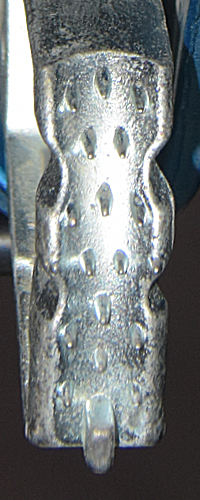 Like most handleless eccentric cam chest ascenders, the AC-30 ascender
is left-handed. This ascender is 119 mm. tall, 80 mm.
wide, 33 mm. thick, and weighs 140 g. The ascender shell is a subtriangular blue anodized shape bent
from 3.9 mm. aluminum sheet. The rope channel is formed by
bending the right side of the ascender into a U. The rope
channel is 15 mm. wide. The main sling attachment
point is located below the cam and behind the rope channel. A
second attachment point is located above the cam, also behind
the rope channel. The shell is bent backwards at both points to
provide clearance between the attachment slings and the main rope.
This accounts for the rather large thickness of this ascender.
The lower attachment point is an oval-shaped opening that measures 18.2
mm. high by 15.3 mm. wide. The upper is a distorted 15.3 mm. round hole. The left side of the shell is bent on an
inclined axis to form another U. A hole drilled through both
sides of the U accepts a semi-tubular rivet. The cam and cam spring
are mounted on this rivet. The head of the rivet is in the rear. The pivot is centered 48 mm. from the inside of the
rope groove. There is a stamped cam stop near the cam pivot.
Like most handleless eccentric cam chest ascenders, the AC-30 ascender
is left-handed. This ascender is 119 mm. tall, 80 mm.
wide, 33 mm. thick, and weighs 140 g. The ascender shell is a subtriangular blue anodized shape bent
from 3.9 mm. aluminum sheet. The rope channel is formed by
bending the right side of the ascender into a U. The rope
channel is 15 mm. wide. The main sling attachment
point is located below the cam and behind the rope channel. A
second attachment point is located above the cam, also behind
the rope channel. The shell is bent backwards at both points to
provide clearance between the attachment slings and the main rope.
This accounts for the rather large thickness of this ascender.
The lower attachment point is an oval-shaped opening that measures 18.2
mm. high by 15.3 mm. wide. The upper is a distorted 15.3 mm. round hole. The left side of the shell is bent on an
inclined axis to form another U. A hole drilled through both
sides of the U accepts a semi-tubular rivet. The cam and cam spring
are mounted on this rivet. The head of the rivet is in the rear. The pivot is centered 48 mm. from the inside of the
rope groove. There is a stamped cam stop near the cam pivot.
The cam is a plated skeletonized steel casting. The cam radius, measured from the pivot, increases from 37 to 52 mm. over an angle of 39°, giving a 27° cam angle. The cam has number of small conical teeth, all of which have their axes approximately parallel to the lower surface of the cam. The tooth pattern is (3.2)^2(1.2)^2(B). The B stands for a 4.4 mm. high, 2.3 mm. wide, and 3/6 mm. long bar. There are two notches on each side of the cam face, presumable
for mud relief. Unlike some other ascenders, the inner cam face
radius appears to be constant.
A spring-loaded manual safety (anodized aluminum alloy) is mounted on an axle riveted to the center of the cam. The normal action of the spring holds the safety against the cam. The safety has a 11 mm. long, 5.9 mm. diameter pin to provide a better grip. When the cam is opened, the shell interferes with the safety tab, thus preventing opening the cam. If the safety is moved away from the cam (opposing the spring), the tab will clear the shell and the cam will open. At full open the safety can be released and the spring will hold the a long arm against the back of the shell, locking the cam open.
The front of the ascender is stamped with "AC-30," the Anthron logo, "ROPES," and "ø8-13 mm." The rear is stamped with "1002-B, the Anthron logo, and
"CE0123."
The differences between Versions A, B, and C are mainly cosmetic and do not affect field performance.
[ Top
| Version A
| Version B
| Return to E.C. Ascenders
]
Version C
(#294)
Technical Details
I acquired my Anthron AC-30 from Rescue Technology in 2009.
Like most handleless eccentric cam chest ascenders, the Anthron ascender
is left-handed. This ascender is 119 mm. tall, 80 mm.
wide, 33 mm. thick, and weighs 140 g. The ascender shell is a subtriangular blue anodized shape bent
from 3.9 mm. aluminum sheet. The rope channel is formed by
bending the right side of the ascender into a U. The rope
channel is 15 mm. wide. The main sling attachment
point is located below the cam and behind the rope channel. A
second attachment point is located above the cam, also behind
the rope channel. The shell is bent backwards at both points to
provide clearance between the attachment slings and the main rope.
This accounts for the rather large thickness of this ascender.
The lower attachment point is an oval-shaped opening that measures 18.2
mm. high by 15.3 mm. wide. The upper is a distorted 15.3 mm. round hole. The left side of the shell is bent on an
inclined axis to form another U. A hole drilled through both
sides of the U accepts a semi-tubular rivet. The cam and cam spring
are mounted on this rivet. The head of the rivet is in the rear. The pivot is centered 48 mm. from the inside of the
rope groove. There is a stamped cam stop near the cam pivot.
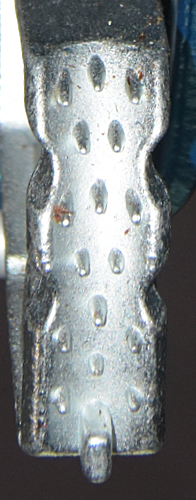 The cam is a plated skeletonized steel casting. The cam radius, measured from the pivot, increases from 37 to 52 mm. over an angle of 39°, giving a 27° cam angle. The cam has number of small conical teeth, all of which have their axes approximately parallel to the lower surface of the cam. The tooth pattern is (3.2)^2(1.2)^2(B). The B stands for a 4.4 mm. high, 2.3 mm. wide, and 3/6 mm. long bar. There are two notches on each side of the cam face, presumable
for mud relief. Unlike some other ascenders, the inner cam face
radius appears to be constant.
The cam is a plated skeletonized steel casting. The cam radius, measured from the pivot, increases from 37 to 52 mm. over an angle of 39°, giving a 27° cam angle. The cam has number of small conical teeth, all of which have their axes approximately parallel to the lower surface of the cam. The tooth pattern is (3.2)^2(1.2)^2(B). The B stands for a 4.4 mm. high, 2.3 mm. wide, and 3/6 mm. long bar. There are two notches on each side of the cam face, presumable
for mud relief. Unlike some other ascenders, the inner cam face
radius appears to be constant.
A spring-loaded manual safety (aluminum alloy) is mounted on an axle riveted to the center of the cam. The normal action of the spring holds the safety against the cam. The safety has a 11 mm. long, 5.9 mm. diameter pin to provide a better grip. When the cam is opened, the shell interferes with the safety tab, thus preventing opening the cam. If the safety is moved away from the cam (opposing the spring), the tab will clear the shell and the cam will open. At full open the safety can be released and the spring will hold the a long arm against the back of the shell, locking the cam open.
The front of the ascender is printed with "AC-30," the Anthron logo, "ROPES," "Ø8-13 mm," a Reading-Is-Dangerous icon, and"0508-1." The rear is printed with
"CE0123," "ANTHRON," the Anthron logo, and "EN 567."
The differences between Versions A, B, and C are mainly cosmetic and do not affect field performance.
[ Top
| Version A
| Version B
| Version C
]



